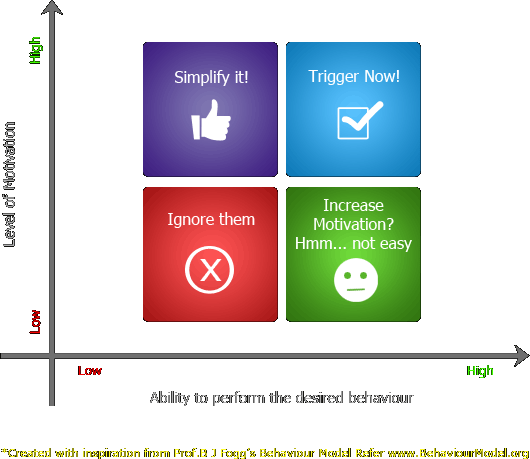Home > Consulting > Behaviour Modelling and Persuasion > Behaviour change through persuasion
Behaviour change through persuasion
We often get confused with many terms being used interchangeably to convey the same meaning. For instance, in the context of behaviours, words like activities, tasks and behaviours are used. However, behaviours are in fact different from tasks, activities and goals. We give some guidelines below to help you define behaviours.
Good definitions of behaviours...
- Are not related to processes or even tasks
- Would affect people not in a short term, but potentially over a longer period
- Have more to do with habits or ways of doing things
- Involve creating new behaviours, changing the existing ways or stopping bad ones
- Are independent of attitudes and personalities

Behaviour is a function of motivation and ability, says Prof. B.J.Fogg. We have created the above framework, based on Fogg Behaviour Model, which helps us map the behaviours, motivation and ability of people. Behaviour depends on how motivated users are, their ability and response to the right triggers for action. People's behaviours can be changed by motivating them, making it simple and/or inciting them to act.
How to change behaviours
- Help people do what they already want to do
- Place triggers on the paths of motivated people who are able to do the desired behaviours
- Focus on increasing ability by making tasks easier for users
- Use persuasion not only in messaging, but in designing the products and services
- Use gamification aspects such as rewards, redemptions etc. to encourage positive behaviours
- Help synchronise people's online and offline behaviours
Brochures
Texavi Corporate Brochure - Our Offerings & Services
Texavi IMAGINEERING - 2013 brochure
Recent Blog Posts
Top tips for the new-age business analyst
Once an analyst, always an analyst
The New Age Business Analyst is here
Roundup of Texavi's IMAGINEERING-INDIA, 2013 Conference
Pervasive, persuasive, personal & wearable - Why Mobile is here to stay
Presentations
Tools, methods and techniques for Newage Business Analyst
Collaborative product development through innovation games
Mastering the art and science of business analysis

